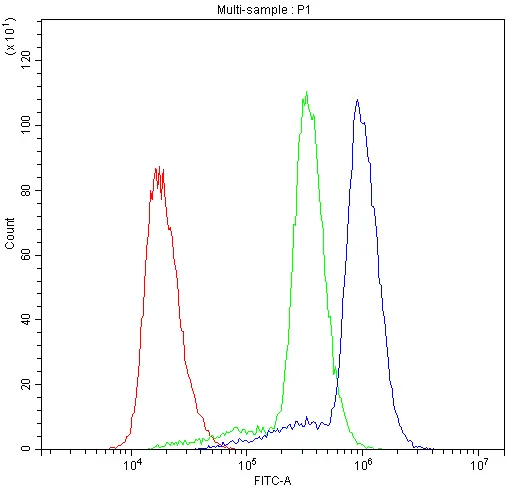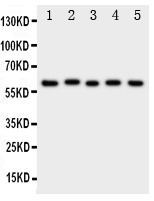
FACS analysis of U937 cells using GTX01177 ASIC3 antibody. Blue : Primary antibody Green : Isotype control Red : No antibody control Antibody amount : 1microg/1x10? cells
ASIC3 antibody
GTX01177
ApplicationsFlow Cytometry, Western Blot
Product group Antibodies
ReactivityHuman, Mouse, Rat
TargetASIC3
Overview
- SupplierGeneTex
- Product NameASIC3 antibody
- Delivery Days Customer9
- Antibody SpecificitySuperfamily members of ASIC3 are not reactive to this antibody.
- Application Supplier NoteWB: 0.1-0.5microg/ml. FACS: 1-3microg/1x106 cells. *Optimal dilutions/concentrations should be determined by the researcher.Not tested in other applications.
- ApplicationsFlow Cytometry, Western Blot
- CertificationResearch Use Only
- ClonalityPolyclonal
- Concentration0.5 mg/ml
- ConjugateUnconjugated
- Gene ID9311
- Target nameASIC3
- Target descriptionacid sensing ion channel subunit 3
- Target synonymsACCN3; acid sensing (proton gated) ion channel 3; acid-sensing ion channel 3; amiloride-sensitive cation channel 3, testis; DRASIC; modulatory subunit of ASIC2a; neuronal amiloride-sensitive cation channel 3; proton-gated cation channel subunit; SLNAC1; testis sodium channel 1; TNaC1
- HostRabbit
- IsotypeIgG
- Protein IDQ9UHC3
- Protein NameAcid-sensing ion channel 3
- Scientific DescriptionThis gene encodes a member of the degenerin/epithelial sodium channel (DEG/ENaC) superfamily. The members of this family are amiloride-sensitive sodium channels that contain intracellular N and C termini, two hydrophobic transmembrane regions, and a large extracellular loop, which has many cysteine residues with conserved spacing. The member encoded by this gene is an acid sensor and may play an important role in the detection of lasting pH changes. In addition, a heteromeric association between this member and acid-sensing (proton-gated) ion channel 2 has been observed as proton-gated channels sensitive to gadolinium. Alternatively spliced transcript variants have been described. [provided by RefSeq, Feb 2012]
- ReactivityHuman, Mouse, Rat
- Storage Instruction-20°C or -80°C,2°C to 8°C
- UNSPSC12352203

